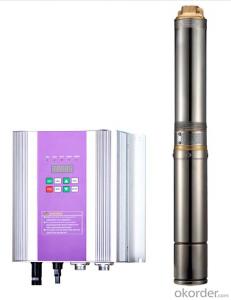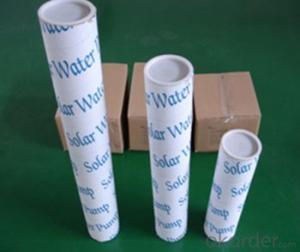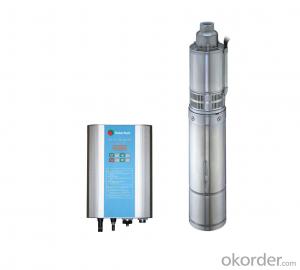Solar Energy Systems Alberta - DC Solar Pumps & DC Solar Pumping System
- Loading Port:
- Shekou
- Payment Terms:
- TT OR LC
- Min Order Qty:
- 20 set
- Supply Capability:
- 500000 set/month
OKorder Service Pledge
OKorder Financial Service
You Might Also Like
Product
Solar Water Pump is the pumping facility driven by solar energy, which consists of a solar pumping inverter and a pump. Solar water pumps kit is called solar pumping system combining with solar arrays designed according to different head and daily water flow for application. System is widely utilized for agriculture irrigation,desert control,pasture animal husbandry,city landscaping,daily water supply, etc.
In recent years, with the development of photovoltaic products from city application to huge demands of agriculture,pasture,desert areas, Solar Pond Pump has become the leading products combining photovoltaic industry with traditional industry such as agriculture water conservancy,desert control,daily water supply,city landscaping, etc.
Solar Pump driven by infinite solar energy, works from sunrise, and stops at sunset, need no connection to grid power nor diesel oil and battery. System can irrigate directly or store water instead of electricity in a reservoir. Solartech Solar fountain Pumps works with sprinkling irrigation, drip irrigation and infiltrating irrigation facilities, can be more efficient for water saving and dramatically lower the cost of using fossil energy.
Technical Features
♦ High efficient DC brushless motor requires less solar array. Rich social benefits.
♦ Optional centrifugal pump for big flow and helical rotor pump for high lift.
♦ High efficient semiconductor device used in main circuit. High reliability. Up to 98% conversion efficiency
of controller.
♦ Independent intellectual property of dynamic VI maximum power point tracking (MPPT) algorithm. Fast
response and good stability. 99% MPPT efficiency.
♦ Full automatic operation. Complete protection functions. Integrated with water level monitor to prevent
overflow and dry running.
♦ Full aluminum alloy case. IP52 protection grade. Ambient temperature: -20~+60℃.
Product Specifications
Model | Rated Power | Max. Flow | Max. Lift | Daily Water Supply | Outlet Dia. | Pump Dia. |
PSD600C | 600W | 4.5 m3/h | 30 m | 10 - 20 m3 | 1"1/4 | 4" |
PSD600H | 600W | 2 m3/h | 100 m | 5 - 10 m3 | 1"1/4 | 4" |
Solar Array Configuration
Max. Input Power | Max. Input Current | Max. Open Circuit Voltage | Recommended MPP Voltage |
1000W | 15A | 150VDC | 60 - 120VDC |
Recommended Design | Solar Panel | Connection | Total Power |
Configuration 1 | 190W / 35Vmp | 2 pcs x 2 strings | 760W |
Configuration 2 | 250W / 30Vmp | 3 pcs x 1 string | 750W |
Performance Curve
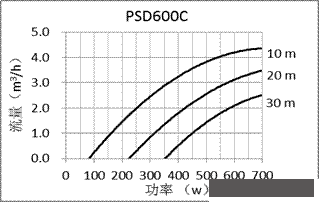
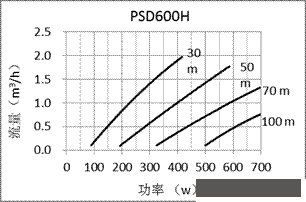
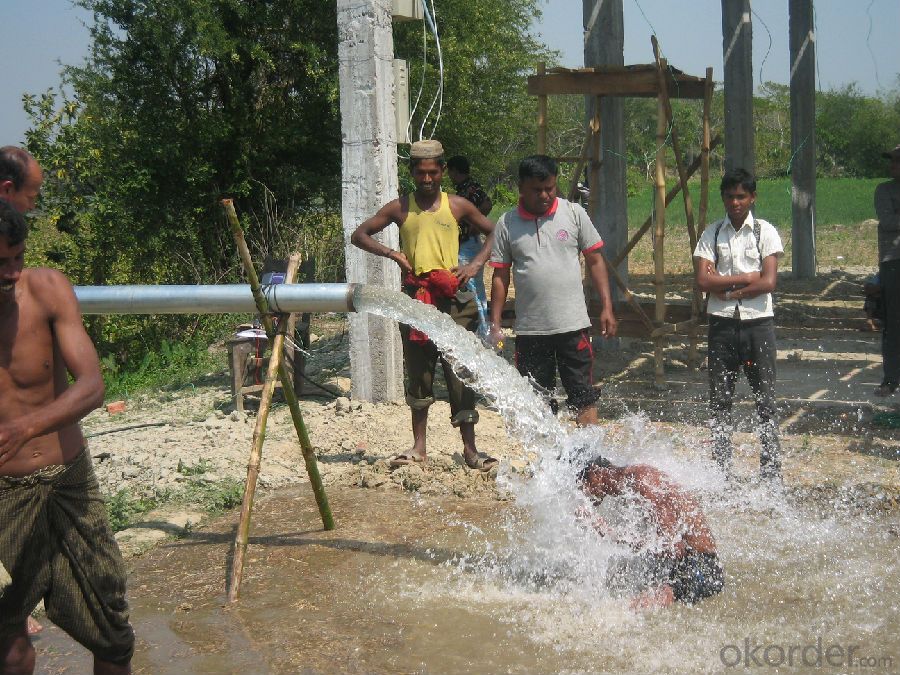
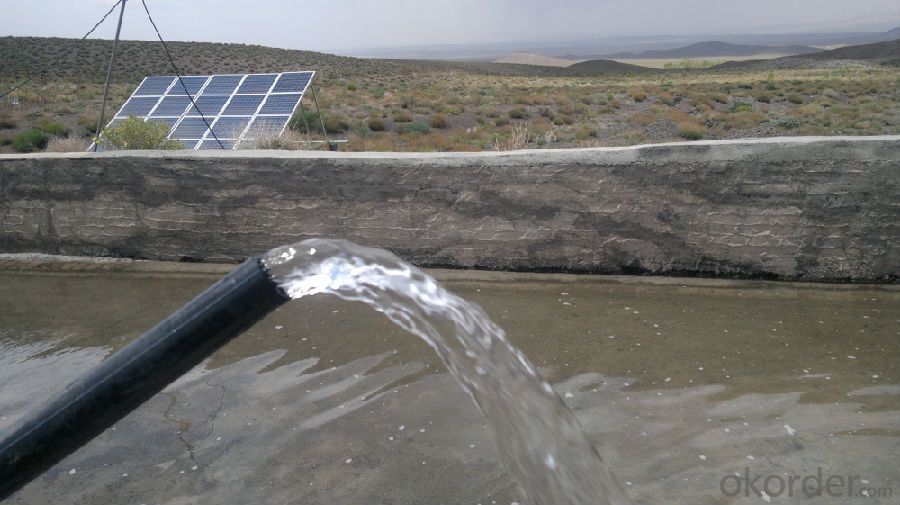
- Q: Can solar energy systems be integrated into existing electrical systems?
- Yes, solar energy systems can be integrated into existing electrical systems. These systems can be designed to work alongside traditional electricity sources, allowing solar energy to supplement or replace grid power. Integration typically involves installing solar panels, inverters, and a connection to the existing electrical system. This integration enables the seamless use of solar power and helps reduce reliance on fossil fuels.
- Q: Can solar energy systems be integrated with battery storage?
- Yes, solar energy systems can be integrated with battery storage. Battery storage allows excess energy generated from solar panels to be stored and used during times when the sun is not shining, such as at night or during cloudy days. This integration helps provide a continuous and reliable source of electricity, reducing reliance on the grid and maximizing the benefits of solar energy.
- Q: Can solar energy systems be integrated into building design?
- Yes, solar energy systems can be integrated into building design. In fact, integrating solar energy systems into building design is becoming increasingly common and is considered a sustainable and cost-effective approach to generating electricity. There are various ways to incorporate solar energy systems into building design, including rooftop solar panels, solar facades, and solar windows. Rooftop solar panels are the most commonly used method of integrating solar energy systems into building design. They can be installed on the roofs of buildings, either as standalone structures or integrated into the roof itself. These panels capture sunlight and convert it into electricity, which can be used to power the building or be fed back into the grid. Solar facades are another way to integrate solar energy systems into building design. These systems involve installing solar panels on the outer walls of buildings. They not only generate electricity but also act as a protective layer, reducing heat gain and improving the building's energy efficiency. Solar windows are a relatively new development in building-integrated solar energy systems. These windows are designed with built-in transparent solar cells that can capture sunlight and generate electricity while still allowing natural light to enter the building. Solar windows have the potential to revolutionize building design by seamlessly integrating renewable energy generation into the building envelope. Integrating solar energy systems into building design offers several advantages. First and foremost, it allows buildings to generate their own electricity, reducing reliance on fossil fuel-based power sources and lowering utility bills. Additionally, it contributes to the reduction of greenhouse gas emissions, promoting a cleaner and more sustainable environment. Moreover, solar energy systems can enhance the aesthetic appeal of buildings, turning them into visually striking examples of sustainable architecture. In conclusion, solar energy systems can indeed be integrated into building design. With various options available, including rooftop solar panels, solar facades, and solar windows, buildings can generate their own clean, renewable electricity, reduce their carbon footprint, and contribute to a more sustainable future.
- Q: Can solar panels be installed on different types of roofs?
- Yes, solar panels can be installed on different types of roofs, including pitched roofs, flat roofs, metal roofs, and concrete tile roofs. The specific installation method may vary depending on the roof type, but with proper design and mounting equipment, solar panels can be successfully installed on various roof surfaces.
- Q: Can solar energy systems be used for agricultural irrigation?
- Yes, solar energy systems can be used for agricultural irrigation. Solar-powered water pumps and irrigation systems are becoming increasingly popular and cost-effective, enabling farmers to harness renewable energy to pump water from wells, rivers, or reservoirs for crop irrigation. This reduces reliance on fossil fuels and helps mitigate environmental impacts while providing a sustainable solution for agricultural water needs.
- Q: Are there any risks of electrical arcing with solar energy systems?
- Solar energy systems have inherent risks of electrical arcing. This occurs when insulation in electrical components breaks down, causing electricity to flow through non-conductive materials like air. The consequences can be hazardous, including fire and damage to the system. There are several factors that can lead to electrical arcing in solar energy systems. Faulty wiring, loose connections, and damage to solar panels are common culprits. These issues increase the likelihood of electrical arcing, which can result in overheating, component melting, and even fires. To mitigate these risks, it is crucial to have qualified professionals install and maintain the solar energy system in accordance with industry standards and regulations. Regular inspections and maintenance are necessary to identify and address potential issues that could cause electrical arcing. In addition, using high-quality electrical components and implementing proper grounding techniques can help reduce the risk of electrical arcing. Safety measures such as circuit breakers, surge protectors, and arc fault circuit interrupters (AFCIs) can provide further protection against electrical arcing. In conclusion, while solar energy systems have many benefits, it is important to be mindful of the risks of electrical arcing. By ensuring proper installation, maintenance, and adherence to safety guidelines, these risks can be minimized, allowing for the safe and efficient operation of solar energy systems.
- Q: What is net metering and how does it work?
- Net metering is a billing arrangement that allows individuals or businesses with solar panels or other renewable energy systems to receive credit for any excess electricity they generate and feed back into the grid. The process of net metering works by installing a bi-directional meter that can measure both the electricity consumed from the grid and the excess electricity generated by the renewable energy system. When the renewable energy system produces more electricity than is being used, the excess is sent back to the grid, and the meter runs in reverse, effectively crediting the system owner for the surplus energy. This credit can then be used to offset the electricity consumed from the grid during times when the renewable energy system is not generating enough power, such as at night or during cloudy days. The system owner only pays for the net amount of electricity used from the grid, which is the difference between the electricity consumed and the electricity generated. Net metering provides several benefits. First, it allows individuals and businesses to reduce their electricity bills by offsetting their consumption with the excess energy they generate. Second, it promotes the use of renewable energy sources, as it provides a financial incentive for individuals to invest in solar panels or other renewable energy systems. Moreover, net metering helps to reduce the strain on the electrical grid by distributing the generation of electricity across multiple sources. Net metering policies and regulations vary by country and state, so it is important for individuals and businesses to familiarize themselves with the specific rules and guidelines in their area. Overall, net metering is a win-win solution that benefits both renewable energy system owners and the environment.
- Q: Can solar energy systems be used in powering theme parks or water parks?
- Yes, solar energy systems can definitely be used to power theme parks or water parks. Solar energy is a clean and renewable source of power that can provide a sustainable and cost-effective solution for meeting the energy needs of these establishments. Theme parks and water parks require a significant amount of electricity to operate attractions, lighting, water pumps, and other facilities. Installing solar panels can help reduce their reliance on conventional energy sources and decrease their carbon footprint. The large open spaces available in theme parks and water parks are ideal for installing solar panels, which can be mounted on rooftops, carports, or ground-mounted arrays. Solar energy systems can generate electricity by converting sunlight into usable energy through photovoltaic (PV) panels. These panels can be integrated into the infrastructure of the park discreetly and efficiently. The energy generated during the day can be used immediately to power rides, lighting, and other equipment, and any excess energy can be stored in batteries for use during periods of low sunlight or at night. Furthermore, solar energy systems can provide a reliable source of power and reduce the vulnerability of theme parks and water parks to power outages or disruptions in the grid. This is particularly important in areas prone to extreme weather events. By incorporating backup battery storage systems, solar energy can provide a constant and uninterrupted power supply even during emergencies. In addition to the environmental and reliability benefits, solar energy systems can also provide long-term cost savings for theme parks and water parks. While the initial installation cost might be higher, the operational costs are significantly reduced as the sun provides free and abundant energy. Over time, the savings on electricity bills can offset the initial investment, resulting in substantial cost savings for the park's owners. Overall, solar energy systems have the potential to revolutionize the power supply of theme parks and water parks. By harnessing the sun's energy, these establishments can not only reduce their environmental impact but also achieve long-term cost savings and enhanced energy reliability.
- Q: What is a solar battery?
- A solar battery, also known as a solar energy storage system or solar storage battery, is a device that stores electrical energy generated by solar panels for later use. It is an essential component in solar power systems, as it allows the excess electricity produced during the day to be stored and used during periods of low or no sunlight, such as at night or on cloudy days. Solar batteries work by converting the direct current (DC) electricity produced by solar panels into alternating current (AC) electricity, which can be used to power household appliances and devices. They store this energy in chemical form, typically using different types of rechargeable batteries such as lithium-ion or lead-acid batteries. The stored energy can be used at any time, providing a reliable and continuous supply of electricity even when sunlight is not available. This is particularly beneficial for residential and commercial applications, as it helps to reduce reliance on the grid and allows for greater energy independence. In addition to providing backup power, solar batteries can also help optimize the utilization of solar energy. By storing excess electricity during periods of high production and discharging it during times of high demand, solar batteries can help to maximize the self-consumption of solar energy and minimize reliance on the grid. This can result in significant cost savings and increased efficiency for solar power system owners. Overall, solar batteries play a crucial role in enabling the efficient and reliable use of solar energy. They provide a sustainable and environmentally friendly solution for storing and utilizing solar power, contributing to the growth of renewable energy and reducing dependence on fossil fuels.
- Q: Can solar energy systems be connected to the grid?
- Yes, solar energy systems can be connected to the grid. This is known as grid-tied or grid-connected solar power. By connecting to the grid, excess electricity generated by the solar system can be fed back into the grid, allowing for a two-way flow of electricity and enabling homeowners or businesses to earn credits for the surplus energy they produce.
Send your message to us
Solar Energy Systems Alberta - DC Solar Pumps & DC Solar Pumping System
- Loading Port:
- Shekou
- Payment Terms:
- TT OR LC
- Min Order Qty:
- 20 set
- Supply Capability:
- 500000 set/month
OKorder Service Pledge
OKorder Financial Service
Similar products
Hot products
Hot Searches
Related keywords





















